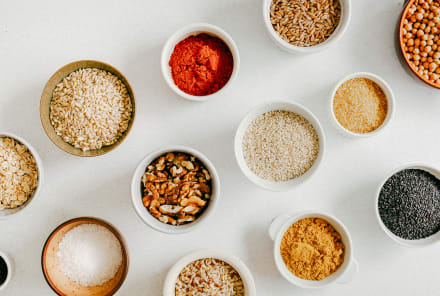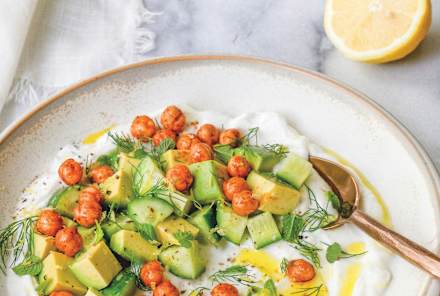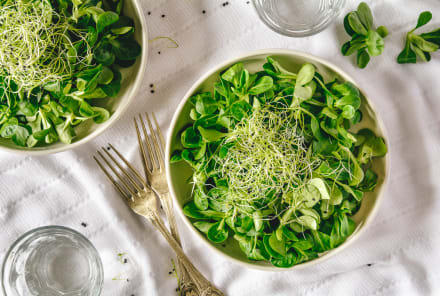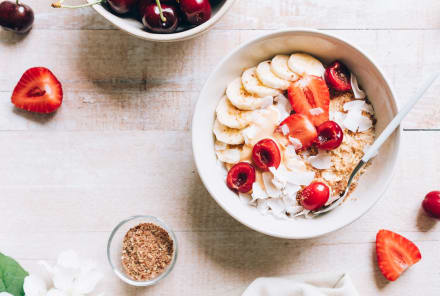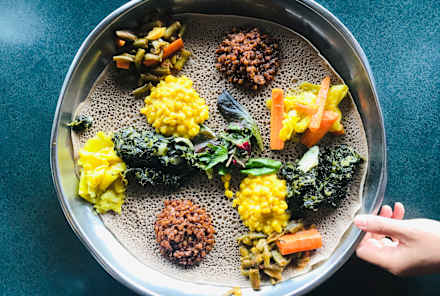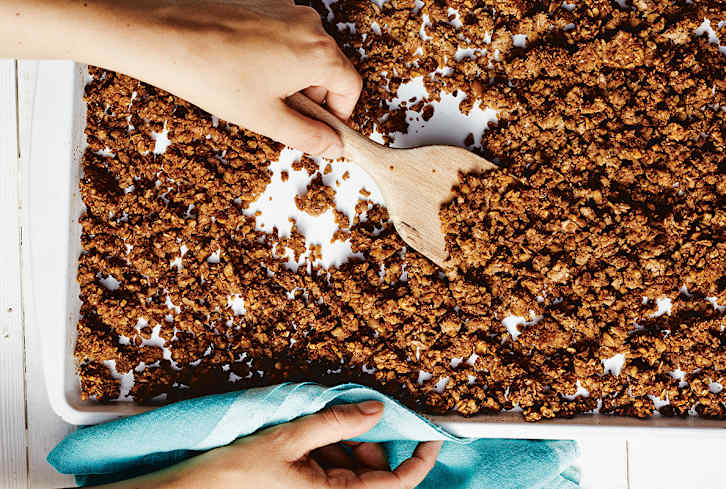Advertisement
The Importance Of Lysine + The Top High-Lysine Foods To Eat


Lysine is an important micronutrient with many health benefits. But how can you be sure you're getting enough of this essential amino acid in your diet? To find out, we spoke with nutrition experts who share the best sources of lysine, the benefits of eating lysine-rich foods, how to get enough as a vegetarian, and more.
Amino acid overview.
If you remember back to high school biology class, amino acids are the building blocks of protein—one of the three macronutrients in the human diet, along with carbohydrates and fats.
Both plant and animal proteins are made up of 20 amino acids1. The human body needs all of them to produce the proteins required for optimal health.
Eleven of these amino acids are "nonessential" and are produced in sufficient quantities by your body. The remaining nine are "essential," meaning they must be acquired through diet since your body doesn't produce adequate amounts.
Among the essential amino acids are lysine and the branched-chain amino acids (BCAAs) leucine, isoleucine, and valine. BCAAs are well-researched and championed nutrients by the fitness community for their role in muscle protein synthesis (MPS)2 and recovery3.
"The building and repair of tissue proteins is termed protein synthesis," Eric Williamson, Ph.D., R.D., a registered dietitian, exercise nutrition expert, and founder of Unlocked Fitness and Nutrition, tells mindbodygreen. "This process allows our body to replace damaged or dysfunctional organ tissues. It's also important to build muscle proteins in response to exercise for gains in muscle mass, strength, speed, and endurance."
"As soon as you turn on protein synthesis, then you need all 20 [amino acids]," Don Layman, Ph.D., a leading amino acid researcher at the University of Illinois at Urbana-Champaign, previously explained on the mindbodygreen podcast.
What is lysine, and why is it important?
Clearly, each of the 20 amino acids has unique properties, benefits, and roles. Like all other amino acids, lysine is essential for healthy growth, development, and functioning4. In addition, lysine is crucial for producing carnitine5, a vital compound in energy production that converts fat into energy.
An older study from 20076 found that most healthy adults require around 14 milligrams (mg) of lysine per pound (30 milligrams per kilogram) of body weight daily.
For a 160-pound person, this equates to 2,240 mg (2.24 grams) of lysine per day. Another study7 suggested that the optimal lysine concentration for adults is 45 mg per gram of protein intake, the second highest amino acid concentration behind leucine.
Summary
Health benefits of lysine.
Lysine is an essential nutrient that offers several health benefits, including:
It may improve bone health.
Lysine helps your body absorb calcium8, which is vital for strong, healthy bones. Also, lysine aids in the formation of collagen, a protein critical for bones and connective tissues.
In a recent human-based study9, certain essential amino acids, including lysine, were associated with decreased bone loss that naturally occurs from aging.
It supports healthy immune function.
Lysine helps produce various hormones, enzymes, and antibodies to support the immune system. In addition, it offers antiviral properties that may protect against the herpes simplex virus, with some research10 indicating it improves nutrient balance in the body to inhibit the spreading of the virus.
It may promote muscle growth.
Lysine plays a pivotal role in skeletal muscle growth by increasing protein uptake in muscles and MPS, according to one animal study11.
What if you're vegetarian?
Research12 shows that lysine is typically lower in plant-based proteins than animal-based ones. That's because most animal proteins are complete proteins (contain sufficient amounts of all nine essential amino acids), while many plant proteins lack some amino acids.
But that doesn't mean vegetarians and vegans can't get adequate lysine in their diet.
Strategically pairing plant-based proteins13 that complement one another's amino acid profiles to form complete proteins can help ensure you get enough of each essential amino acid, including lysine.
Additionally, supplementing with a high-quality vegan protein powder can help you meet your daily lysine intake.
"Vegans and vegetarians can obtain adequate lysine for protein synthesis by ensuring they pair low-lysine plant proteins with high-lysine foods in the same meal," explains Williamson. "For example, the lack of lysine in rice can be made up for by consuming lentils, which have a high lysine content."
Foods high in lysine:
- Cheese (Parmesan): 3.3 grams14 per 100 grams
- Soybeans: 2.7 grams15 per 100 grams
- Chicken: 2.6 grams16 per 100 grams
- Shrimp: 2.2 grams per 100 grams
- Tuna: 2.1 grams17 per 100 grams
- Pork: 1.9 grams16 per 100 grams
- Lentils: 1.7 grams18 per 100 grams
- Beans: 1.5 grams19 per 100 grams
- Lamb: 1.5 grams20 per 100 grams
- Beef: 1.4 grams21 per 100 grams
- Pumpkin seeds: 1.2 grams22 per 100 grams
- Pistachios: 1.1 grams per 100 grams
- Eggs: 0.9 gram23 per 100 grams
- Yogurt: 0.8 gram24 per 100 grams
- Oats: 0.7 gram25 per 100 grams
- Spirulina: 0.3 gram26 per 100 grams
- Quinoa: 0.2 gram27 per 100 grams
Foods low in lysine:
- Broccoli: 0.1 gram28 per 100 grams
- Brown rice: 0.1 gram29 per 100 grams
- Potatoes: 0.09 gram30 per 100 grams
- Buckwheat: 0.07 gram31 per 100 grams
- Zucchini: 0.07 gram32 per 100 grams
- Yams: 0.06 gram33 per 100 grams
- Beets: 0.06 gram34 per 100 grams
- Tomatoes: 0.04 gram35 per 100 grams
- Bananas: 0.05 gram36 per 100 grams
- Celery: 0.03 gram37 per 100 grams
- Cucumber: 0.03 gram38 per 100 grams
- Apples: 0.01 gram39 per 100 grams
Sample meal plan for lysine.
If you need some inspiration for getting more lysine in your diet, consider trying the following sample meal plan:
- Breakfast: Oatmeal with berries and pumpkin seeds, and two eggs
- Lunch: Tofu stir-fry with mushrooms, sundried tomatoes, snow peas, avocado, and quinoa
- Dinner: Chicken breast with lentils, roasted cauliflower, and steamed spinach
- Snack: Yogurt with sliced pears
Frequently Asked Questions
What foods have the most lysine?
Animal proteins such as chicken, shrimp, tuna, beef, and lamb generally have the highest amounts of lysine. However, plant proteins like soybeans, lentils, beans, and pumpkin seeds also provide considerable amounts of this essential nutrient.
What vegetables are high in lysine?
Lysine-rich vegetables include sundried tomatoes, peppers, lima beans, mushrooms, green peas, cauliflower, snow peas, and cooked leafy greens like spinach and kale.
What fruit is high in lysine?
Though fruit is typically low in protein, some contain lysine and other essential amino acids. High-lysine fruits include avocado, dried apricots, dried mango, and pears.
What foods are high in lysine and low in arginine?
Arginine is a conditionally essential amino acid that older research has shown helps the herpes virus replicate to cause cold sores. Eating foods high in lysine and low in arginine may help block arginine activity and keep cold sores at bay. These foods include yogurt, cheese, dairy, mangoes, apricots, pears, fish, and chicken.
The takeaway.
Lysine is an essential amino acid required for proper growth, bodily functions, and energy production. It can also support bone health, boost the immune system, and promote muscle growth.
While lysine is typically found in animal proteins, plant-based eaters can get enough by combining high-lysine plant-based foods with other plant proteins. This will help ensure the consumption of complete protein sources and meet daily lysine requirements without any extra effort.
Whether you're a meat eater or vegan, meeting your daily protein needs with healthy protein sources will go a long way in ensuring that you're not low in lysine.
39 Sources
- https://www.ncbi.nlm.nih.gov/books/NBK234922/
- https://www.ncbi.nlm.nih.gov/pmc/articles/PMC5568273/
- https://www.ncbi.nlm.nih.gov/pmc/articles/PMC6212987/
- https://www.ncbi.nlm.nih.gov/books/NBK557845/
- https://ods.od.nih.gov/factsheets/Carnitine-HealthProfessional/
- https://www.sciencedirect.com/science/article/pii/S0022316622092914?via%3Dihub
- https://pubmed.ncbi.nlm.nih.gov/33000162/
- https://www.ncbi.nlm.nih.gov/pmc/articles/PMC5852680/
- https://pubmed.ncbi.nlm.nih.gov/36232583/
- https://www.ncbi.nlm.nih.gov/pmc/articles/PMC6419779/
- https://www.ncbi.nlm.nih.gov/pmc/articles/PMC6953079/
- https://www.ncbi.nlm.nih.gov/pmc/articles/PMC6245118/
- https://www.ncbi.nlm.nih.gov/pmc/articles/PMC6140426/
- https://fdc.nal.usda.gov/fdc-app.html#/food-details/170848/nutrients
- https://fdc.nal.usda.gov/fdc-app.html#/food-details/174270/nutrients
- https://fdc.nal.usda.gov/fdc-app.html#/food-details/168312/nutrients
- https://fdc.nal.usda.gov/fdc-app.html#/food-details/173706/nutrients
- https://fdc.nal.usda.gov/fdc-app.html#/food-details/174284/nutrients
- https://fdc.nal.usda.gov/fdc-app.html#/food-details/173734/nutrients
- https://fdc.nal.usda.gov/fdc-app.html#/food-details/174370/nutrients
- https://fdc.nal.usda.gov/fdc-app.html#/food-details/174036/nutrients
- https://fdc.nal.usda.gov/fdc-app.html#/food-details/170556/nutrients
- https://fdc.nal.usda.gov/fdc-app.html#/food-details/171287/nutrients
- https://fdc.nal.usda.gov/fdc-app.html#/food-details/330137/nutrients
- https://fdc.nal.usda.gov/fdc-app.html#/food-details/169705/nutrients
- https://fdc.nal.usda.gov/fdc-app.html#/food-details/170091/nutrients
- https://fdc.nal.usda.gov/fdc-app.html#/food-details/168917/nutrients
- https://fdc.nal.usda.gov/fdc-app.html#/food-details/170379/nutrients
- https://fdc.nal.usda.gov/fdc-app.html#/food-details/169704/nutrients
- https://fdc.nal.usda.gov/fdc-app.html#/food-details/170028/nutrients
- https://fdc.nal.usda.gov/fdc-app.html#/food-details/170286/nutrients
- https://fdc.nal.usda.gov/fdc-app.html#/food-details/169291/nutrients
- https://fdc.nal.usda.gov/fdc-app.html#/food-details/170071/nutrients
- https://fdc.nal.usda.gov/fdc-app.html#/food-details/169145/nutrients
- https://fdc.nal.usda.gov/fdc-app.html#/food-details/170050/nutrients
- https://fdc.nal.usda.gov/fdc-app.html#/food-details/173944/nutrients
- https://fdc.nal.usda.gov/fdc-app.html#/food-details/169988/nutrients
- https://fdc.nal.usda.gov/fdc-app.html#/food-details/168409/nutrients
- https://fdc.nal.usda.gov/fdc-app.html#/food-details/168201/nutrients

Why Nutrition Is Key To Changing Your Relationship With Alcohol
Brooke Scheller, DCN, CNS

Why Alcohol Sabotages Your Gut Health & How To Get Back On Track
Brooke Scheller, DCN, CNS

Why Nutrition Is Key To Changing Your Relationship With Alcohol
Brooke Scheller, DCN, CNS

Why Alcohol Sabotages Your Gut Health & How To Get Back On Track
Brooke Scheller, DCN, CNS

Why Nutrition Is Key To Changing Your Relationship With Alcohol
Brooke Scheller, DCN, CNS

Why Alcohol Sabotages Your Gut Health & How To Get Back On Track
Brooke Scheller, DCN, CNS

Why Nutrition Is Key To Changing Your Relationship With Alcohol
Brooke Scheller, DCN, CNS

Why Alcohol Sabotages Your Gut Health & How To Get Back On Track
Brooke Scheller, DCN, CNS
